By: Warren Gray
Copyright © 2023
“I don’t think they play at all fairly. They don’t seem to have any
rules in particular; at least, if there are, nobody attends to them.”
— Lewis Carroll, Alice’s Adventures in Wonderland, 1865
“Of course it’s a violation of international law;
that’s why it’s a covert action!”
— Vice President Al Gore, 1993
“I said (to Vladimir Putin)…‘I’m looking into your eyes,
and I don’t think you have a soul.’ He looked back at me,
and he smiled, and he said, ‘We understand one another.’”
— Vice President Joe Biden, New Yorker interview, 2014
“We don’t have a president; we have a scared child covering
his eyes at a horror movie…Physically, tangibly, change-the-
diaper afraid…terrified…respected by no one, and feared
by no one…And Putin knows it.”
— Retired Lieutenant Colonel Ralph Peters,
New York Post, September 30, 2015
With the brutal war in Ukraine dragging on endlessly, and edging perilously toward the unfathomable abyss of possible, nuclear warfare and World War Three, there’s an increasing need to end Russian President Vladimir Putin’s reckless ambitions before it’s too late. Some NATO nations may consider the bold and highly-risky concept of capturing Putin alive to end the war, or killing him through a Top-Secret, plausibly-deniable raid to make it appear to be an internal coup by dissident, Russian forces.
According to Doctor Alexander Motyl, a professor of political science at Rutgers-Newark University, even the dreaded, Federal Security Service (FSB), in particular, the successor to the notorious, KGB intelligence service, has repeatedly criticized Putin, and recently attempted to embarrass and discredit him, “for his mishandling of the war, and for his refusal to take the blame for the impending, systemic collapse. His proneness to strategic miscalculations can only increase from the pressure of watching the trigger-happy FSB over his shoulder.”
This would certainly not be the first time that such a daring measure was considered. In the closing weeks of World War Two, the secretive Office of Strategic Services (OSS) conceived of Operation Iron Cross. Captain Aaron Bank, who was fluent in German and French, and who would later become the founder of the U.S. Special Forces (10th Special Forces Group), was slated to lead a four-man, OSS “Jedburgh” (named for a rebellious, Scottish, border town) commando team to locate none other than Adolf Hitler himself at his Alpine retreat near Berchtesgaden, and then send for a further 100 specially-trained, anti-Nazi Germans and ex-prisoners of war to parachute into nearby Austria and capture Hitler alive. Major General William J. “Wild Bill” Donovan, the OSS director himself, had personally issued the order: “Tell Bank to get Hitler.”
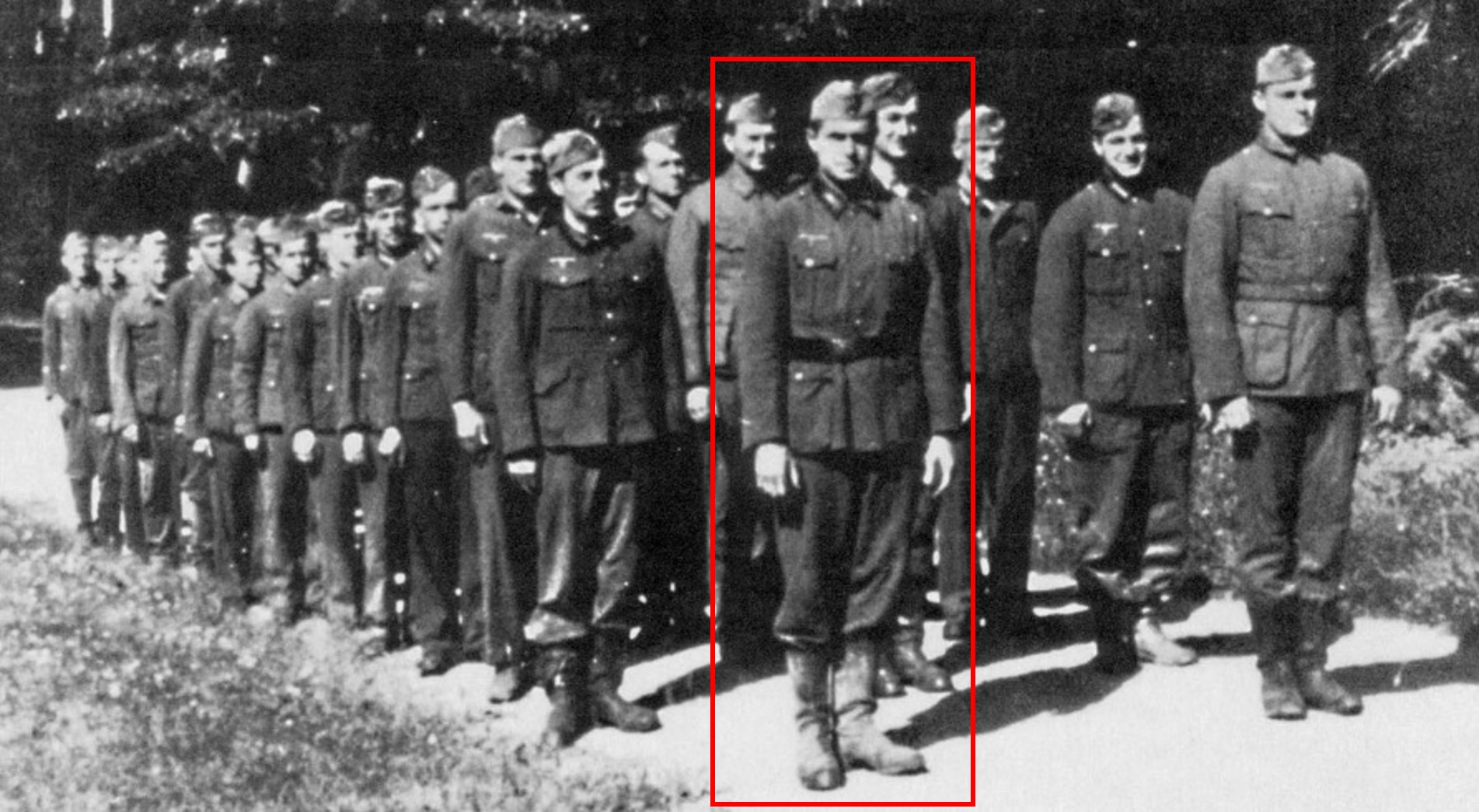
OSS Captain Aaron Bank (outlined in red) with German defectors, in German uniforms for the Operation Iron Cross mission, April 1945. Photo credit: U.S. Army
Iron Cross was slated to begin on April 18, 1945, the very lucky, third anniversary of the highly-successful, Top-Secret, Doolittle Raid to bomb Tokyo and other cities in Japan, and the second anniversary of the equally-successful, Yamamoto Raid to locate and assassinate (using P-38G Lightning fighter planes) Admiral Isoroku Yamamoto, the mastermind behind the horrific Pearl Harbor attack of 1941, and capture Hitler by his 56th birthday, on April 20th, but it was postponed six times due to bad weather in the Berchtesgadener Alps, and was finally cancelled on April 24th, when it became apparent that Hitler would never leave besieged Berlin for his picturesque, Alpine retreat high up in the mountains. It was a very bold and ambitious plan that might have actually worked, had the circumstances been better. My latest book manuscript (from 2020), Alpine Thunder, is strongly based upon this incredible-but-realistic special operations scenario.
Now let’s fast-forward to 2023 and consider the possibility of a similar plan to secretly capture Vladimir Putin in order to hasten the end of the war in Ukraine. Is such an endeavor even possible in today’s world? Actually, it is, but not without some carefully calculated risk. Let’s examine this seemingly impossible, hard-target scenario in detail.
When things in Washington get too hot or stressful for President Joe Biden to handle, he can always retreat to Camp David, Maryland, in the nearby Catoctin Mountains, or to his home compound in Delaware. In the vast Russian Federation, Vladimir Putin has considerably more options, with a variety of palaces, compounds, or other hideouts scattered all over the country. But since the war in Ukraine began, and his paranoia has ratcheted up several notches, he’s had to reconsider the safety of several of his country retreats.
There’s the opulent, $1.3-billion Gelendzhik Palace on the Black Sea southeast of Dzhankhot, but it’s vulnerable to secret raids from NATO ships at sea, just 12 or more nautical miles offshore. Putin still vividly recalled Operation Celestial Balance, near Baraawe, Somalia, south of Mogadishu, on September 14, 2009, when two black U.S. Army AH-6M Little Bird special operations helicopter gunships (the Navy called them “Seabats”) and two unarmed, MH-6M Little Bird transports carrying eight Navy commandos from SEAL Team Six expertly pinpointed al-Shabaab (“the Youth,” in Arabic), terrorist leader Saleh Ali Saleh Nabhan.
The gunships killed him and three more terrorists with .50-caliber, GAU-19/A Gatling guns, and then the SEALs collected the four bodies for positive identification. The special ops raiders came from U.S. Navy warships cruising off the Somali coast, and the operation was a stunning success, as Putin recalls all too well.
Vladimir Putin’s next three options are all dangerously close to Finland, which officially joined the NATO alliance on April 4, 2023. He has an elaborate “Fisherman’s Hut” retreat on the northern shoreline of Lake Ladoga, about 27 miles from the Finnish border, a ski-resort and racetrack complex at Igora, 62 miles from Finland, and has often stayed at his Villa Sellgren (“Putin’s Dacha”) estate near Vyborg, a mere 17 miles from the border, where Russian military defenses are sparse and questionable, at best. He also has a remote, rustic, timber mansion on the Yenisei River near Krasnoyarsk, Siberia, but it’s too far away (2,100 miles east of Moscow) for easy access.
That leaves Putin’s massive, two-and-a-half-mile-long complex spanning the eastern shore of Lake Valdai (or Valdayskoye), in the center of Valdaysky National Park, 214 miles from the Estonian (NATO) border, where he undoubtedly feels much safer. Russians simply call it the “Valdai Residence.” It’s defended by an ultra-long-range battery of SA-21B Growler surface-to-air missiles (SAMs) at Izhitsy, 11 miles to the west, replacing an older, SA-10E Grumble battery there. However, Maxar Technologies satellite imagery of the Izhitsy missile compound dated October 6, 2021, showed NO transporter-erector-launcher (TEL) vehicles deployed in firing positions in the available revetments, so this site was either in a very low state of readiness, or their missiles had already been deployed near the Ukrainian border in preparation for the February 24, 2022, invasion.
Then, there are short-range, SA-22B Greyhound gun-and-missile systems on-site at Lake Valdai, and Khotilovo Air Base is only 36 miles to the southeast, housing various Su-27P/S Flanker-B, Su-35S Flanker-E+, and MiG-31BM/DZ Foxhound-B fighters. This was precisely where Vladimir Putin fled during the rampant, nationwide, anti-war protests of September 2022, so he’s used Lake Valdai recently, and he’ll surely use it again.
Any possible approach routes from NATO territory (meaning Estonia) are guarded by imposing, barrier defenses of SA-21B, SA-22B, and SA-28 Vityaz (“Knight”) missile batteries, the 25th Mechanized Brigade at Luga, the 76th Guards Air Assault Division’s paratroopers and 2nd SpetsNaz (Special Forces) Brigade at Pskov, and the 15th Army Aviation Brigade at Ostrov Air Base, with Ka-52 Alligator, Mi-28N Havoc-B, and Mi-35M1 Hind-E Modified attack helicopters, and various transport helicopters.
Interestingly enough, however, Ostrov Air Base was secretly infiltrated by Ukrainian Special Forces saboteurs nearly 500 miles from home on October 31, 2022, who planted timed explosives on three helicopters, totally destroying two Ka-52s (at $16m each), and severely damaging another Ka-52 and an Mi-28N ($18m) helicopter. They even released video footage of themselves as proof of the daring incursion, preparing what appeared to be a bomb with a six-hour delay mechanism. Did they quietly enter Russia through neighboring Latvia or Estonia? We may never know, but it seems highly likely.
In any case, this very successful Ukrainian Special Forces raid clearly demonstrates that the Russians, as we’ve seen over the first year and few months of open warfare in Ukraine, are far more inept, incompetent, inefficient, and poorly trained than we ever gave them credit for, and their base defenses are not impenetrable, after all, so covert, special operations missions are certainly quite feasible.
Taken at face value, however, raiding the well-defended Lake Valdai complex seems like “Mission: Impossible,” but so did Operation Iron Cross in 1945. How is it humanly possible to infiltrate, and later extract, a covert, special operations team 214 miles inside of Russia, flying past all of these daunting air defenses? You’d have to think “outside the box,” and use some creativity and international cooperation.
The first requirement is for a very small, highly trained, Russian-speaking, commando team of probably no more than six men, to travel lightly and avoid detection. There should be one officer, a sniper, a medic, and three reconnaissance troopers, preferably recruited from the ranks of the 1st Battalion, 10th Special Forces Group (Airborne) in Böblingen, Germany, specializing in Eastern European regions and languages, or from the super-secret, 1st Capabilities Integration Group (Airborne) (1st CIG) at Fort Belvoir, Virginia, or even ex-Special Forces men from the CIA’s elite, paramilitary Special Operations Group (SOG) at Langley, Virginia.
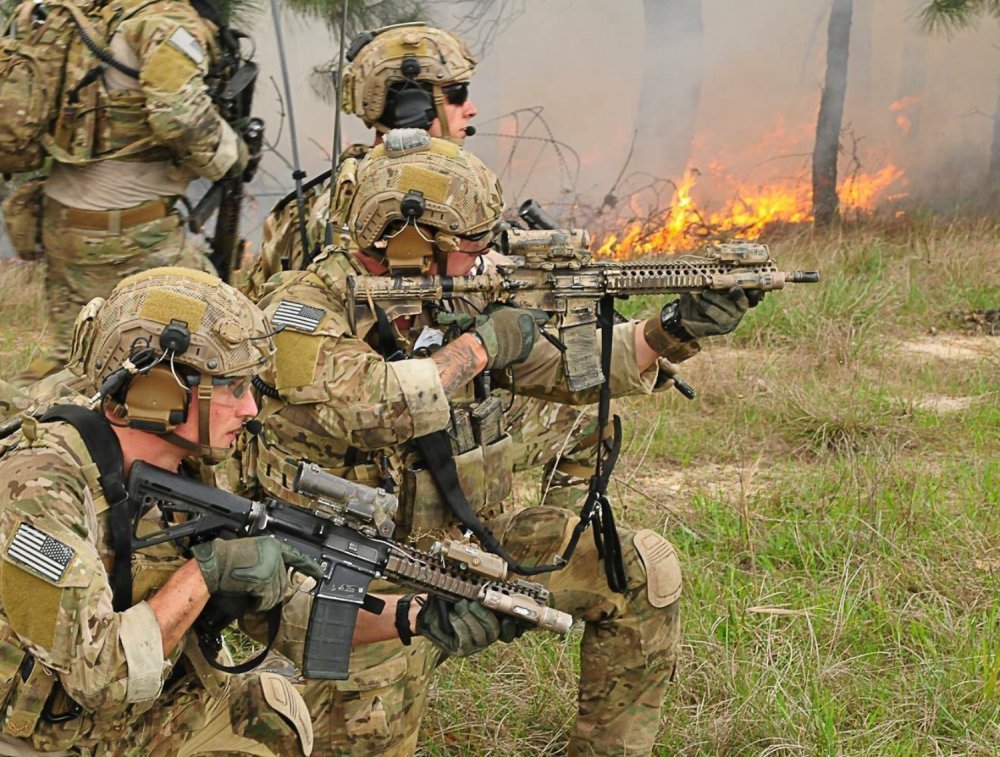
U.S. Army Special Forces team in action. Photo credit: U.S. Army
These half-dozen men should wear sterile uniforms (with all identifying tags removed) of MultiCam camouflage, just like most of the Russian SpetsNaz commando units and special services these days, and carry captured, suppressed, Russian weapons (hopefully including an Orsis T-5000M “Terminator” bolt-action, sniper rifle in .338 Lapua Magnum, with suppressor) or other plausibly-deniable foreign weapons. The Ukrainian government has already captured thousands of Russian weapons over the past year, and probably provided a small percentage to the United States for “testing-and-evaluation” purposes, so Russian weapons, even new AK-12Ks or AK-15s, are unquestionably available.
In fact, The Washington Post reported on April 14, 2023, that according to leaked, U.S. intelligence assessments, “All but one of five Russian Separate SpetsNaz Brigades that returned from combat operations in Ukraine in late summer 2022 suffered significant losses,” and the 22nd SpetsNaz Brigade and two other brigades suffered an estimated 90-to-95-percent attrition rate. One brigade alone, the 346th SpetsNaz, “lost nearly the entire brigade, with only 125 personnel active out of 900 deployed.” So, there should certainly be an abundance of captured, suppressed, SpetsNaz weapons available for this particular covert mission.
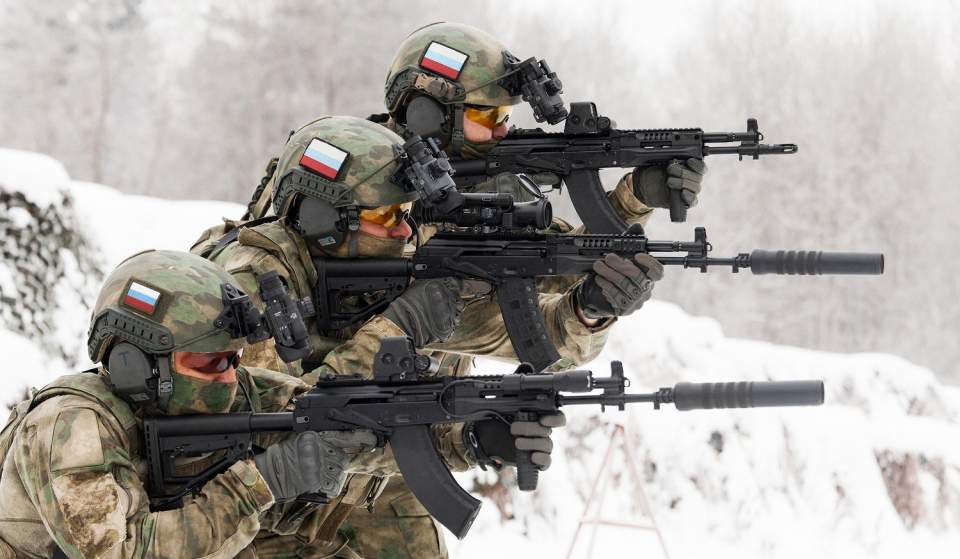
Russian AK-15K carbine, and suppressed AK-12 and AK-15 carbines. Photo credit: The Firearm Blog
Next, you need a discreet, quiet, staging base on friendly soil, not too far from the objective, such as Narva Airfield, Estonia, a half-mile-long grass airstrip less than three miles from the Russian border, and surrounded by trees to the south, east, and west. Then, you’ll need an infiltration method, some type of stealthy aircraft that can safely maneuver past these missile defenses undetected, or at least without undue suspicion. This would have to be accomplished at night, and at very low altitude, by highly skilled pilots.
One very credible option is for the strongly anti-Russian, pro-Ukrainian, Polish Army Aviation service to willingly provide two of their 48 dark-green, Mi-24V/W Hind-E helicopter gunships for mutual support, upgraded with Rafael (Israeli) TopLite FLIR sensors, and each carrying four 132-gallon, external fuel tanks for extended range (620 miles), two new, Rafael Spike-ER anti-tank missiles (five miles’ range) for engaging ground targets, and two Piorun (“Thunderbolt”) heat-seeking missiles (four miles’ range, an improved copy of the shoulder-fired, Russian SA-18 Grouse missile) for engaging any hostile aircraft.
In addition, they each have a nose-mounted, Yak-B .50-caliber Gatling gun with four barrels, and every Hind has seating inside the main cabin for up to eight armed troops. (See my Gunpowder Magazine article on “‘Satan’s Chariot’: The Mi-24 Hind Gunship,” from September 10, 2020.) All Polish markings would necessarily be removed, and they would look almost exactly like the newer, Russian Mi-35M1 Hind-Es from Ostrov at night, adding a vital, tactical confusion-and-deception element to the audacious scenario.
By flying at treetop height (100 feet altitude, or less) in the darkness with night-vision goggles (NVGs) and FLIR sensors for navigation, it’s entirely possible to avoid the deadly, SA-21B, SA-22B, and SA-28 missile batteries, and deliver the raider team to Lake Valdai, but they couldn’t land there safely. The team would have to be dropped into the water in wetsuits at low airspeed near the historic and picturesque Iver (or Valday Iversky) Monastery, dating back to 1653, of the Russian Orthodox Church, at the western edge of the Lake Valdai Exclusion Zone, and swim underwater with scuba gear for just over a mile, to the eastern shoreline, where Putin’s vast complex is located. A waterborne infiltration is simply the safest, quickest, least-detectable method for inserting a covert team there.
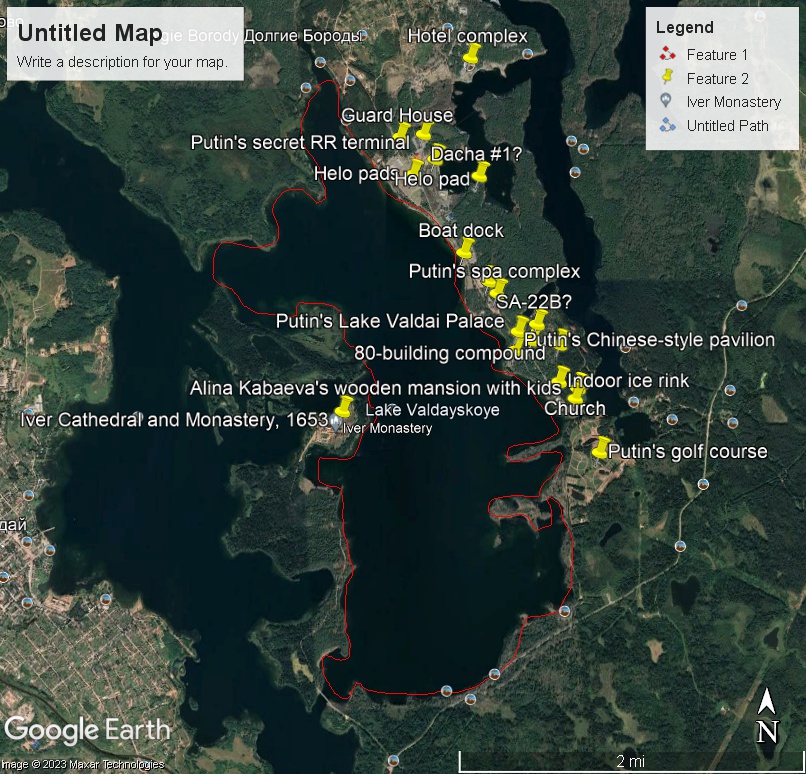
Google Earth satellite image of Putin’s Lake Valdai complex, with the no-fly, Exclusion Zone ringed in red.
Once ashore, our intrepid, Russian-speaking, commando team members would find themselves amid an extensive complex of at least 80 buildings, guarded by Federal Protective Service (FSO) agents dressed in either civilian attire, black uniforms with black berets, or MultiCam field uniforms, depending upon their duties and circumstances. The FSO has been described by Russian journalists as, “This most-mysterious of all Russian special services…is a powerful, multi-purpose, and extremely secretive agency…The FSO as a special service is almost omnipotent.”
These highly capable men are armed with SR-1M Vektor (or Gyurza = “Blunt-nosed viper”) pistols in 9x21mm Gyurza, or newer SR-2 Udav (“Boa”) service handguns, since about 2020, also in the powerful, 9x21mm chambering. This is like firing a standard, 9x19mm pistol with very hot, +P+ ammunition at 1,300-feet per second, using 7N42 armor-piercing rounds to penetrate up to 30 layers of Kevlar body armor at 160 feet.

SR-1M Vektor/Gyurza pistol in 9x21mm, with suppressor. Photo credit: vitalykuzmin.net
FSO rifles and carbines include AK-105 and AK-12 variants in 5.45x39mm, and some SR-3M Vikhr (“Whirlwind,” very popular with the Federal Security Service, or FSB) short carbines with 6.4-inch barrels in 9x39mm. Sniper rifles have included the innovative, Lobaev SVL in .408 CheyTac, the Orsis T-5000M Tochnost (“Precision”) in 7.62x54mmR or .338 Lapua Magnum since 2017, and probably the newer Lobaev DXL-4 Sevastopol in .408 CheyTac, replacing the early, SVL models.
A large, wooden, country-style mansion near the southern end of the complex is used by Putin’s longtime mistress (since 2008), Alina Kabaeva, age 39, a former champion gymnast, and currently a politician and media manager, who has at least two or three male children, ages eight and four (possibly twin sons), by Vladimir Putin. President Putin himself uses the comparatively small (38,000-square-feet), ornate, cream-colored (some call it “golden”) palace in the middle of the pine-forested complex, instead.
Without going into too much detail and revealing the full details of the mission, let’s say that the American commando team manages to either capture or kill Putin late one evening, after several days to a week of constant surveillance, or alternately, they find it impossible to do so. Either way, they now require rapid extraction from the highly dangerous Lake Valdai area, which is a bit trickier and more complicated than just dropping them off by helicopter.
This can be accomplished quite effectively, however, with some minor cooperation from the German government. At Oberpfaffenhofen Special Airport, a factory zone and federal research center in Wessling, southern Germany, the Dornier Seawings aviation company maintains a pair of prototype, demonstrator seaplanes, the sleek Dornier Seastar CD2 (for “Claudius Dornier, Jr.,” the designer, with two prototypes), not yet sold to any external customers. This modern and incredible aircraft is billed by Dornier as the “World’s Most-Advanced, Amphibious Aircraft,” certainly one of the fastest flying boats on the market.
The Seastar uses all-composite, watertight construction, so it’s non-metallic and practically invisible to radar tracking, with twin, overhead, turboprop engines in a push-pull configuration, driving two all-composite, MTV-27, five-blade, “Quiet-Fan” propellers for noise reduction. It holds up to 12 passengers inside, has a range of 1,035 miles, has retractable landing gear for runway landings, cruises at 207 miles per hour, and can land on water in less than 2,800 feet, and take off again in 3,445 feet.

Dornier Seastar CD2 all-composite seaplane. Photo credit: Dornier Seawings
It would be extremely helpful to be able to “borrow” a Seastar for this mission, apply a temporary, easily-removable coat of flat-black paint, and add a U.S. special operations copilot to assist the Dornier test pilot with low-level, night flight. The primary limitation here is the lack of a FLIR sensor, and no prior experience with NVGs. Standing by at Narva Airfield for the extraction request, the Seastar could potentially arrive at Lake Valdai just over one hour later, land very quietly on water inside the Exclusion Zone, pick up the team and any prisoners, and take off again within a few short minutes, hopefully undetected.
If necessary, one of the Polish Mi-24s could provide an armed escort through Russian airspace, but the Seastar’s leisurely cruising speed is right at the maximum-possible speed (208 mph) for the helicopter, so they’d both have to slow down a little to remain together. Vladimir Putin himself has used massive, Beriev Be-200 Altair jet-powered seaplanes in the past to gain access to Lake Valdai, including a noted, state visit by Italian Prime Minister Silvio Berlusconi in 2009, so seaplanes are a very credible option.
This is just one of several possible scenarios for raiding one of Putin’s lavish hideouts while he’s away from Moscow, demonstrating that such a covert mission is, indeed, possible.
Another superb, very modern option would call for just one or two brand-new, readily-available, dark-gray, stealthy, Airbus H160M Guépard (“Cheetah”) twin-engine, all-composite helicopters, currently being delivered to the French Army (80 on order), Navy (49 on order, with two already delivered for search-and-rescue duties by March 27, 2023), and Air Force (40 on order), featuring innovative, five-blade, Blue-Edge active-tracking, all-composite rotor system reducing noise and vibration by at least 50 percent over previous helicopters to a “near-jet” level of smoothness, a shrouded, composite, Fenestron tail-rotor system, and a very quiet (78 decibels) ride.
In fact, the H160 is the world’s first production rotorcraft equipped with Blue-Edge technology, incorporating double-swept, scythe-shaped blades that reduce the noise generation of blade-vortex interactions (BVI.) How did the French get so far ahead of us in advanced, helicopter technology? A Safran Euroflir 410 optronic FLIR sensor provides nighttime navigation and targeting capability.
The innovative H160M is slated to soon replace all 12 SA342M1 Gazelle armed, light scout helicopters of Special Operations Squadron 2 (EOS 2) within the 4th Special Forces Helicopter Regiment (4e RHFS) of the French Army Light Aviation (ALAT) service, so at least a dozen will be assigned to special operations duties.
Incidentally, French pilots from EOS 2 are the most heavily-armed in the world, each equipped with a compact, B&T (Swiss) APC556-PDW carbine in 5.56mm, an H&K (German) MP7A1 personal-defense weapon (PDW) in 4.6x30mm, a Glock-17FR Gen. 5 (Austrian) pistol in 9x19mm, a Wildsteer (French) Blade H-4 combat/survival knife, a Tarrerias-Bonjean (French) CAC (Combat, Assistance, Campaign) folding knife, plus two OFX F1 (French) hand grenades!
Chief Helicopter Pilot Joe Drummelsmith of USB Corp. of Mason, Ohio, flew the sleek, civilian, H160 version in Trenton, New Jersey, in 2018, noting that, “It’s super quiet: quiet in start-up, quiet in cruise. The maneuverability of the aircraft…it’s incredible.”
Furthermore, the new Guépard can easily carry up to 12 passengers, or five fully-equipped commandos, is nearly as fast as the Mi-24 Hind-E (178 to 202 mph) and has enough range capability to reach Lake Valdai and return, with a 22-percent fuel reserve remaining, to account for any delays or emergencies.
The $18-million H160M may also be armed, as desired, with FN .50-caliber gun pods, 20mm cannon pods, unguided rockets, 70mm missiles, and door guns. This “French-Connection” option is perhaps the stealthiest for armed aircraft, but for a lake extraction on water, the Seastar approach is still clearly the best technique.

Airbus H160M Guépard with twin FN D-HMP400 gun pods, and FN MAG door guns. Photo credit: French Ministry of the Armed Forces
All of this discussion leads to one final consideration, that of a possible, land-based extraction farther toward the south. At the far, southern end of the Lake Valdai complex are Putin’s private golf course and elaborate gardens, separated from the main complex area by an inlet, a narrow channel of water 20 yards wide, and accessible only by small boat. The lake itself sits 627 feet above sea level, with the golf course rising another eight feet above the water, in a separate area likely to be only lightly defended, at best.

Putin’s private, Lake Valdai golf course and elaborate gardens. Photo credit: Google Earth
In order to avoid the deadly SA-22B Greyhound missiles on-site, however, any ingressing or departing aircraft would have to fly at a maximum altitude of 30 feet, with the skids of the helicopter only about 14 feet over the lake. It can be done, but it requires expert, special operations pilots with nerves of steel. They could land either on the grassy golf course itself, or on the sandbar at the tip of the wooded peninsula, safely away from the effective range of most Russian small-arms fire from the shoreline.
This is all simply an extension of the CIA’s established and notorious, “extraordinary rendition” program, a euphemism for the state-sponsored, forcible abduction of individuals in another jurisdiction, and transfer to a third state, authorized as a presidential directive by Bill Clinton in 1995, and continued by President George W. Bush during the Global War on Terrorism. In this case, we would directly transfer Putin, if captured alive, to Ukraine, so the Ukrainians could use him as a high-level prisoner of war (POW) for leverage in seeking an end to the current war between Russia and Ukraine. The United States would then officially disavow any knowledge or participation in such an operation, and let the Ukrainians handle it from that point onward.
Could such a daring, covert mission ever become necessary? If push comes to shove, and this unrelenting, high-intensity war in Ukraine escalates even further, how far are we willing to go in order to avert possible nuclear warfare and World War Three?
The French statesman Charles Alexandre de Calonne (1734 to 1842) is said to have originated the famous phrase, “If a thing is possible, consider it done; the impossible? This will be done.” In modern times, the U.S. Armed Forces have adopted this as the bold slogan, “The difficult we do immediately, the impossible takes a little longer.”
One could surely compare the relative difficulty of targeting Vladimir Putin to that of sending men to walk on the Moon in the late 1960s. But as Apollo 13 astronaut/commander Jim Lovell observed, “It’s not a miracle. We just decided to do it.”
Removing Vladimir Putin from power by either capturing or killing him in a plausibly-deniable mission may eventually become the only option for ending this war, and it’s extremely risky, but is also possible. The only question is, do we have the moral courage to actually do what’s necessary?
* * *
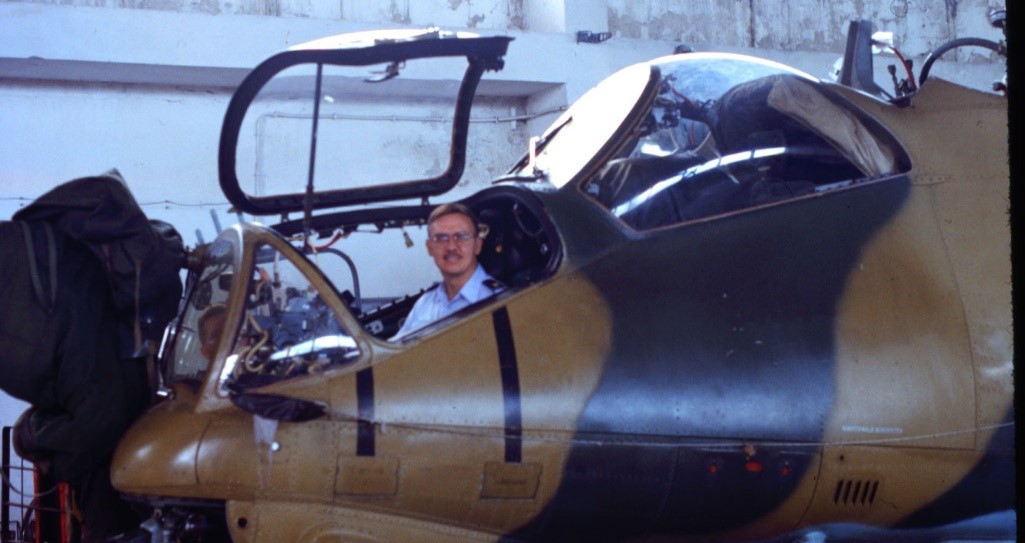
Author in Mi-24V Hind-E helicopter gunship, 2000.
Warren Gray is a retired, U.S. Air Force intelligence officer with experience in joint special operations and counterterrorism. He served in Europe (including Eastern Europe) and the Middle East, earned Air Force and Navy parachutist wings, four college degrees, and was a distinguished graduate of the Air Force Intelligence Operations Specialist Course, and the USAF Combat Targeting School. He is currently a published author, historian, and hunter. You may visit his website at: warrengray54.vistaprintdigital.com

